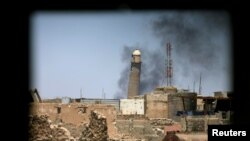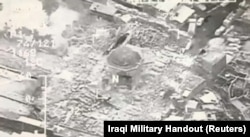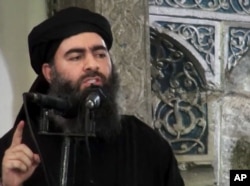Islamic State fighters on Wednesday blew up Mosul’s Grand Mosque of al-Nuri, one of Iraq’s most important architectural and religious landmarks, as security forces closed in on the historic site, according to Iraqi and U.S. commanders.
They dismissed claims by IS propagandists accusing coalition warplanes of destroying the mosque where jihadist leader Abu Bakr al-Baghdadi made his 2014 declaration announcing his caliphate after his forces took over significant portions of Iraq and Syria.
This past week, U.S.-backed Iraqi forces have been pushing deeper into the last remaining redoubts held by IS militants in Iraq’s second city and had hoped to seize the mosque in time for Eid al-Fitr, a festival that marks the end of the holy month of Ramadan. The festival is due to begin in Iraq June 25 or 26.
‘Historical crime’
Gen. Abdulamir Yarallah, overall commander of the Mosul offensive, described the destruction of the mosque as a “historical crime,” accusing IS militants of intentionally blowing up the medieval mosque as his forces closed in on the building.
U.S. commanders joined their Iraqi counterparts in denying the IS accusation and lamenting the loss of a mosque that dates back to the 12th century, and whose leaning al-Hadba minaret earned the city the nickname the “humpback.”
“As our Iraqi Security Force partners closed in on the al-Nuri mosque, ISIS destroyed one of Mosul and Iraq’s great treasures,” said Maj. Gen. Joseph Martin, the top U.S. commander in Iraq.
He added: “This is a crime against the people of Mosul and all of Iraq, and is an example of why this brutal organization must be annihilated. The responsibility of this devastation is laid firmly at the doorstep of ISIS.”
Footage of the explosion that engulfed the mosque, and shared widely on social media sites, would appear to indicate a ground blast. There were no signs of shells or missiles striking the building.
For both sides fighting for control of Mosul, the mosque held huge symbolic importance. Nur al-Din Mahmoud Zangi, a Turkic ruler of Mosul and Aleppo, ordered that the mosque be built two years before his death in 1172. He was revered by jihadists for his opposition to Shia Islam and for waging war against Christians during his 28-year reign.
One of his lieutenants, Saladin, who succeeded him, went on to capture Jerusalem from the Crusaders in 1187 and to lay the foundations of the Ayyubid empire.
When al-Baghdadi announced the establishment of his caliphate in June 2014 from the pulpit of the mosque, the symbolism wasn’t missed across the Muslim world, evoking as it did the memories of both Nur al-Din and Saladin.
Dressed in a black robe and wearing a black turban indicating his claim to be descended from the Prophet Muhammad’s Quraysh tribe, al-Baghdadi proclaimed: “God, the Great and Almighty, has bestowed upon your mujahideen brothers the grace of victory and conquest, and has enabled them to do that after long years of waging jihad, showing patience, and fierce fighting against the enemies of God.”
Mosul’s Old City
Since al-Baghadi’s proclamation, the black flag of the terror group has flown from the cylindrical minaret covered with elaborate brickwork deep in Mosul’s Old City. Iraqi forces earlier Wednesday said they had started a push toward the mosque, whether they would have been able to seize it before the end of Ramadan isn’t clear.
On Sunday, Iraqi forces announced they had begun storming the IS-held Old City as the campaign to retake the city entered its ninth month.
“This is the last chapter,” Gen. Abdul Ghani al-Asadi, an Iraqi commander, told the Reuters news agency.
But fighting in the Old City, like much of west Mosul, has proved more daunting than the fight to capture east Mosul, thanks to narrow streets making it difficult for armed vehicles to maneuver.
IS fighters have slowed advances with improvised explosives and mines, and persistent sniper fire. Militants have harassed Iraqi soldiers by re-appearing unexpectedly in streets thought to have been cleared of them by using tunnel networks.
Little of the original mosque complex remained even well before IS appeared on the scene. Only the minaret, some columns and the mihrab, a niche in the wall at the point nearest to Mecca, remained from the 12th-century construction.
Even so, the mosque was a landmark of incalculable importance for the residents of Mosul — it will be as sorely missed as the Twin Towers are for New Yorkers or the cathedrals of Coventry and Dresden, which were destroyed in the Second World War.
Local lore claimed the minaret leaned because it was bowing to Prophet Muhammad, but engineers say the lean was caused by prevailing northwesterly winds and the sun’s impact on the bricks.
Just days before IS seized Mosul, United Nations Educational, Scientific and Cultural Organization (UNESCO) announced it was planning to start a conservation program aimed at stabilizing the minaret. The minaret’s foundations had been damaged in the Iran-Iraq war when bombs cracked underground pipes nearby allowing sewage to collect near the base.
In October, Kurdish officials told VOA that IS fighters have been instructed to wreak as much destruction as they could on Mosul, if they were unable to hold the city against Iraqi troops and Kurdish peshmerga militiamen.
An official with Iraqi Kurdistan’s ruling party said the destruction order was sent by Abu Bakr al-Baghdadi, who told his followers to leave devastation and mass killings behind.












